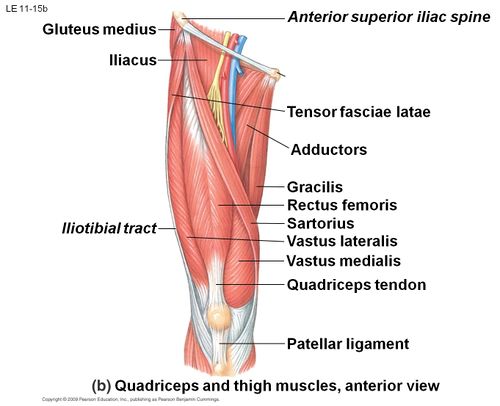Quadriceps Muscle
Original Editor - Your name will be added here if you created the original content for this page.
Top Contributors - Lucinda hampton, Kim Jackson, Nikhil Benhur Abburi, Oyemi Sillo, Joao Costa, Wanda van Niekerk, Chrysolite Jyothi Kommu and Aminat Abolade
Introduction[edit | edit source]
The Quadriceps femoris is a hip flexor and a knee extensor. It is located in the anterior compartment of the thigh. This muscle is composed of 4 sub components:
- Rectus femoris
- Vastus lateralis
- Vastus medialis
- Vastus intermedius (see links for further elaboration)
The rectus femoris originates at the ilium, thus crossing both the hip and knee joint along its course. This anatomy allows for hip flexion and knee extension. The remaining muscles originate on the femur and function solely as knee extensors. Innervation of these muscles is by the femoral nerve. The quadriceps are primarily active in kicking, jumping, and running[1].
Clinical relevance[edit | edit source]
Injury to the quadriceps muscle group can be painful and debilitating. Strains, tears and contusions of the quadriceps are common in athletics and result in lost time from training and competition.
Myositis Ossificans-(MO) A complication associated with severe quadriceps contusions; this is a non-neoplastic proliferation of bone and cartilage in the area of contusion injury. In contusions, the reported incidence is between 9 and 17%. MO should be suspected if symptoms worsen after 2–3 weeks accompanied by loss of knee flexion and persistent swelling
Sub Heading 3[edit | edit source]
Resources[edit | edit source]
- bulleted list
- x
or
- numbered list
- x
References[edit | edit source]
- ↑ Kary JM. Diagnosis and management of quadriceps strains and contusions. Current reviews in musculoskeletal medicine. 2010 Oct 1;3(1-4):26-31. Available from:https://www.ncbi.nlm.nih.gov/pmc/articles/PMC2941577/ (last accessed 7.2.2020)







